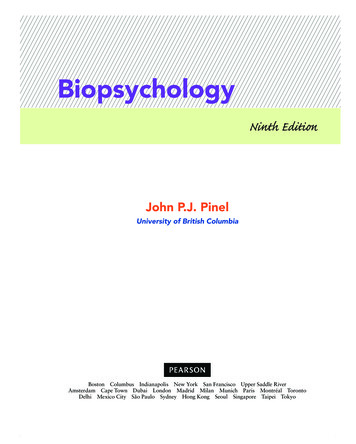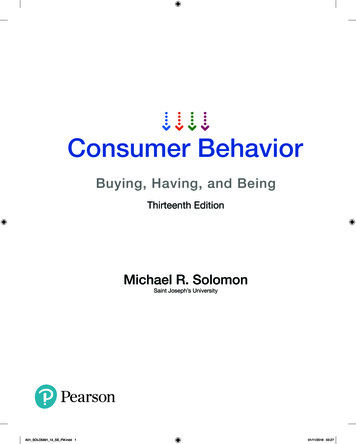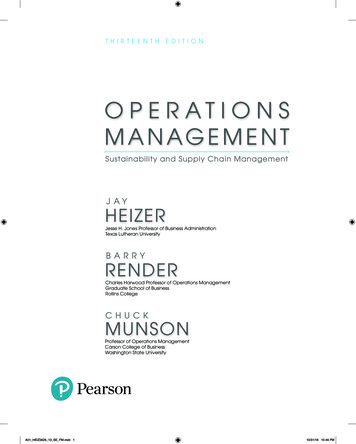
Transcription
BiopsychologyNinth EditionJohn P.J. PinelUniversity of British ColumbiaBoston Columbus Indianapolis New York San Francisco Upper Saddle RiverAmsterdam Cape Town Dubai London Madrid Milan Munich Paris Montréal TorontoDelhi Mexico City São Paulo Sydney Hong Kong Seoul Singapore Taipei TokyoA01 PINE5576 09 SE FM.indd 19/4/13 12:11 AM
To Maggie, the love of my life.Acquisitions Editor: Amber ChowEditorial Assistant: Alexis RodriguezDirector of Marketing: Brandy DawsonMarketing Assistant: Frank AlarconSenior Managing Editor: Linda BehrensProcurement Manager: Mary FischerSenior Procurement Specialist: Diane PeiranoProgram Manager: Diane SzuleckiCreative Director: Blair BrownSenior Art Director: Janet Slowik CruzInterior and Cover Design: Wee DesignCover Designer: Steven BarnesCover Art: Portrait of the young woman:Photodisc/Getty Images; Brain fibers: Pasieka/Science SourceMedia Production Manager: Peggy BlissMedia Project Manager: Pamela WeldinDigital Media Editor: Lisa DotsonFull-Service Project Management: Integra-Chicago /Angelique ChavezComposition: Integra-ChicagoPrinter/Binder: Courier / KendallvilleCover Printer: Lehigh-Phoenix Color / HagerstownText Font: Minion Pro 10.5/12Credits and acknowledgments borrowed from other sources and reproduced, with permission, in this textbook appear on appropriate page within text or on page 533.Copyright 2014, 2011, 2009 by Pearson Education, Inc. All rights reserved. Printed in the United States of America. This publication is protected by Copyright and permission should be obtained from the publisher prior to any prohibited reproduction; storagein a retrieval system; or transmission in any form or by any means, electronic, mechanical, photocopying, recording, or likewise.To obtain permission(s) to use material from this work, please submit a written request to Pearson Education, Inc., PermissionsDepartment, One Lake Street, Upper Saddle River, New Jersey 07458, or you may fax your request to 201-236-3290.Many of the designations by manufacturers and seller to distinguish their products are claimed as trademarks. Where thosedesignations appear in this book, and the publisher was aware of a trademark claim, the designations have been printed in initialcaps or all caps.Library of Congress Cataloging-in-Publication DataPinel, John P. J.Biopsychology / John P.J. Pinel, University of British Columbia.—Ninth edition.pages cmIncludes bibliographical references and index.ISBN 978-0-205-91557-6 (alk. paper)1. Psychobiology—Textbooks. I. Title.QP360.P463 2015612.8—dc23201303068510 9 8 7 6 5 4 3 2 1Student Edition: ISBN 10:0-205-91557-4ISBN 13: 978-0-205-91557-6A La Carte Edition: ISBN 10:0-205-97976-9ISBN 13: 978-0-205-97976-9A01 PINE5576 09 SE FM.indd 29/4/13 12:11 AM
Brief Contents10Part OneWhat Is Biopsychology?1Biopsychology as a Neuroscience1What Is Biopsychology, Anyway?11Brain Damage and NeuroplasticityCan the Brain Recover from Damage?Learning, Memory, and AmnesiaHow Your Brain Stores InformationPart TwoPart FiveFoundations of BiopsychologyBiopsychology of Motivation2Evolution, Genetics, and Experience3Anatomy of the Nervous System4Thinking about the Biology of BehaviorSystems, Structures, and Cells That Make UpYour Nervous SystemNeural Conduction and SynapticTransmissionHow Neurons Send and Receive Signals5The Research Methodsof BiopsychologyUnderstanding What Biopsychologists Do2012511314Hunger, Eating, and HealthWhy Do Many People Eat Too Much?Hormones and SexWhat’s Wrong with the Mamawawa?Sleep, Dreaming, andCircadian RhythmsHow Much Do You Need to Sleep?7615Drug Addiction and the Brain’sReward CircuitsChemicals That Harm with Pleasure100233259287314341368Part SixPart ThreeDisorders of Cognition and EmotionSensory and Motor Systems166The Visual System7Mechanisms of Perception: Hearing,161Touch, Smell, Taste, and AttentionHow We See129The Left Brain and the Right Brain17The Sensorimotor SystemHow You Move188Biopsychology of Emotion, Stress,and HealthFear, the Dark Side of EmotionHow You Know the World8Lateralization, Language, and theSplit Brain18Biopsychology of PsychiatricDisordersThe Brain Unhinged393423446Part FourBrain Plasticity9Development of the Nervous System 213From Fertilized Egg to YouiiiA01 PINE5576 09 SE FM.indd 39/4/13 12:11 AM
ContentsPrefaceTo the StudentAbout the AuthorxvixxiiixxiiiPart OneCase 2: Becky, Moniz, andPrefrontal LobotomyThemes RevisitedThink about ItKey TermsQuick ReviewWhat Is Biopsychology?1Biopsychology as a1NeuroscienceWhat Is Biopsychology,Anyway?Part TwoThe Case of Jimmie G.,the Man Frozen in TimeFour Major Themes of This Text331.1What Is Biopsychology?41.2What Is the Relation betweenBiopsychology and the OtherDisciplines of Neuroscience?4What Types of Research Characterizethe Biopsychological Approach?Human and Nonhuman SubjectsExperiments and NonexperimentsPure and Applied Research45571.31.4What Are the Divisions of Biopsychology? 8Physiological Psychology8Psychopharmacology9Neuropsychology9The Case of Mr. R., the Brain-DamagedStudent Who Switched to Architecture9Psychophysiology9Cognitive Neuroscience10Comparative Psychology111.5Converging Operations: How DoBiopsychologists Work Together?1.6Scientific Inference: How DoBiopsychologists Study theUnobservable Workings of the Brain?13Critical Thinking aboutBiopsychological ClaimsCase 1: José and the Bull14151.7ivA01 PINE5576 09 SE FM.indd 41517181818Foundations of Biopsychology2Evolution,Genetics, andExperienceThinking about theBiology of Behavior2.12.2122.3Thinking about the Biology of Behavior:From Dichotomies to InteractionsIs It Physiological, or Is It Psychological?Is It Inherited, or Is It Learned?Problems with Thinking about theBiology of Behavior in Terms of TraditionalDichotomiesThe Case of the Man Who Fell Out of BedCase of the Chimps with MirrorsThe Case of the Thinking Student2021212222232324Human EvolutionEvolution and BehaviorCourse of Human EvolutionThinking about Human EvolutionEvolution of the Human BrainEvolutionary Psychology: UnderstandingMate BondingThinking about Evolutionary Psychology2426273032Fundamental GeneticsMendelian GeneticsChromosomes: Reproduction andRecombination35353334369/4/13 12:12 AM
ContentsChromosomes: Structure and ReplicationSex Chromosomes and Sex-Linked TraitsGenetic Code and Gene ExpressionMitochondrial DNAHuman Genome ProjectModern Genetics: Growth of Epigenetics2.42.5Epigenetics of Behavioral Development:Interaction of Genetic Factors andExperienceSelective Breeding of “Maze-Bright”and “Maze-Dull” RatsPhenylketonuria: A Single-Gene MetabolicDisorderDevelopment of BirdsongGenetics of Human PsychologicalDifferencesDevelopment of Individuals versusDevel opment of Differences amongIndividualsMinnesota Study of Twins Reared ApartA Look into the Future: Two Kindsof Twin StudiesThemes RevisitedThink about ItKey TermsQuick Review33.1Anatomy of theNervous System3738384041413.6434344454465152523.2Cells of the Nervous SystemAnatomy of NeuronsGlia: The Forgotten Cells5656563.3Neuroanatomical Techniquesand DirectionsNeuroanatomical TechniquesDirections in the Vertebrate NervousSystem53546161623.4Spinal Cord643.5Five Major Divisions of the Brain64A01 PINE5576 09 SE FM.indd 5Neural Conductionand Synaptic76TransmissionThe Lizard, a Case of Parkinson’sDisease774.1Resting Membrane PotentialRecording the Membrane PotentialIonic Basis of the Resting Potential7878784.2Generation and Conductionof Postsynaptic Potentials794.3Integration of PostsynapticPotentials and Generation of ActionPotentials794.4Systems, Structures,and Cells That Make UpYour Nervous SystemGeneral Layout of the Nervous SystemDivisions of the Nervous SystemMeninges, Ventricles, and CerebrospinalFluidBlood–Brain Barrier6565656666687074747575How Neurons Sendand Receive Signals46474749494950Major Structures of the ephalonTelencephalonLimbic System and the Basal GangliaThemes RevisitedThink about ItKey TermsQuick Reviewv4.5Conduction of Action PotentialsIonic Basis of Action PotentialsRefractory PeriodsAxonal Conduction of Action PotentialsConduction in Myelinated AxonsThe Velocity of Axonal ConductionConduction in Neurons without AxonsThe Hodgkin-Huxley Model inPerspectiveSynaptic Transmission: ChemicalTransmission of Signals amongNeuronsStructure of SynapsesSynthesis, Packaging, and Transportof Neurotransmitter MoleculesRelease of Neurotransmitter MoleculesActivation of Receptors byNeurotransmitter MoleculesReuptake, Enzymatic Degradation, andRecyclingGlia, Gap Junctions, and 9/4/13 12:12 AM
viContents4.64.7NeurotransmittersAmino Acid NeurotransmittersMonoamine NeurotransmittersAcetylcholineUnconventional NeurotransmittersNeuropeptidesPharmacology of Synaptic Transmissionand BehaviorHow Drugs Influence Synaptic TransmissionBehavioral Pharmacology: Three InfluentialLines of ResearchThemes RevisitedThink about ItKey TermsQuick nding WhatBiopsychologists Do101Part One M ethods of Studyingthe Nervous System5.15.25.3Methods of Visualizing and Stimulatingthe Living Human BrainContrast X-RaysX-Ray Computed TomographyMagnetic Resonance ImagingPositron Emission TomographyFunctional MRIDiffusion Tensor ImagingTranscranial Magnetic Stimulation102102102103103104105106Recording Human PsychophysiologicalActivityScalp ElectroencephalographyMagnetoencephalographyMuscle TensionEye MovementSkin ConductanceCardiovascular Activity106106108108108109109Invasive Physiological ResearchMethodsStereotaxic SurgeryLesion MethodsElectrical StimulationInvasive Electrophysiological RecordingMethodsA01 PINE5576 09 SE FM.indd 6109110110111111113113113Genetic EngineeringGene Knockout TechniquesGene Replacement TechniquesFantastic Fluorescenceand the Brainbow115115115113113115Part Two B ehavioral ResearchMethods of BiopsychologyThe ResearchMethodsof Biopsychology 100The Ironic Case of Professor P.Pharmacological Research MethodsRoutes of Drug AdministrationSelective Chemical LesionsMeasuring Chemical Activityof the BrainLocating Neurotransmitters andReceptors in the BrainNeuropsychological TestingModern Approach to NeuropsychologicalTestingTests of the Common NeuropsychologicalTest BatteryTests of Specific NeuropsychologicalFunctionFrontal-Lobe Function5.7Behavioral Methods of CognitiveNeuroscience5.8Biopsychological Paradigms of AnimalBehaviorParadigms for Assessment of SpeciesCommon BehaviorsTraditional Conditioning ParadigmsSeminatural Animal Learning ParadigmsThemes RevisitedThink about ItKey TermsQuick rt ThreeSensory and Motor Systems66.1The Visual System 129How We SeeThe Case of Mrs.Richards: FortificationIllusions and theAstronomer130Light Enters the Eye and Reachesthe RetinaPupil and the LensEye Position and Binocular Disparity1311321339/4/13 12:12 AM
Contents6.2Retina and Translation of Lightinto Neural SignalsCone and Rod VisionSpectral SensitivityEye MovementVisual Transduction: The Conversionof Light to Neural Signals1396.3From Retina to Primary Visual CortexRetinotopic OrganizationThe M and P Channels6.4Seeing Edges142Lateral Inhibition and ContrastEnhancement142Receptive Fields of Visual Neurons143Receptive Fields: Neuronsof the Retina-Geniculate-Striate System144Receptive Fields: Simple Cortical Cells145Receptive Fields: Complex Cortical Cells 146Organization of Primary Visual Cortex146The Case of Mrs. Richards, Revisited147Changing Concept of VisualReceptive Fields: Contextual Influencesin Visual Processing1476.56.6Seeing ColorComponent and Opponent ProcessingColor Constancy and the RetinexTheoryCortical Mechanisms of Visionand Conscious AwarenessDamage to Primary Visual Cortex:Scotomas and CompletionThe Case of the Physiological PsychologistWho Made Faces DisappearDamage to Primary Visual Cortex:Scotomas, Blindsight, and ConsciousAwarenessThe Case of D.B., the Man Confusedby His Own BlindsightFunctional Areas of Secondaryand Association Visual CortexDorsal and Ventral StreamsThe Case of D.F., the Woman WhoCould Grasp Objects She Did NotConciously SeeThe Case of A.T., the Woman WhoCould Not Accurately Grasp UnfamiliarObjects That She SawProsopagnosiaR.P., a Typical ProsopagnosicAkinetopsiaTwo Cases of Drug-Induced AkinetopsiaConclusionA01 PINE5576 09 SE FM.indd 7Themes RevisitedThink about ItKey TermsQuick isms ofPerception: Hearing,Touch, Smell, Taste,161and AttentionHow You Knowthe WorldThe Case of the Man Who Could SeeOnly One Thing at a Time7.17.3viiPrinciples of SensorySystem OrganizationHierarchical OrganizationThe Case of the Man Who MistookHis Wife for a HatFunctional SegregationParallel ProcessingSummary Model of Sensory SystemOrganizationThe Auditory SystemThe EarFrom the Ear to the PrimaryAuditory CortexSubcortical Mechanisms of SoundLocalizationAuditory CortexEffects of Damage to the AuditorySystemSomatosensory System: Touchand PainCutaneous ReceptorsDermatomesTwo Major Somatosensory PathwaysCortical Areas of SomatosensationEffects of Damage to the PrimarySomatosensory CortexSomatosensory System and AssociationCortexThe Case of W.M., Who ReducedHis Scotoma with His HandSomatosensory AgnosiasThe Case of Aunt Betty, Who LostHalf of Her BodyRubber-Hand IllusionPerception of PainThe Case of Miss C., the WomanWho Felt No PainNeuropathic 721731741751751751761761771771771799/4/13 12:12 AM
viiiContents7.4Chemical Senses: Smell and TasteOlfactory SystemGustatory SystemBrain Damage and the Chemical SensesBroad Tuning vs. Narrow Tuning1791801811821827.5Selective AttentionChange BlindnessNeural Mechanisms of AttentionSimultanagnosiaThemes RevisitedThink about ItKey TermsQuick Review18418418518618618618718788.18.2The Sensorimotor188SystemThree Principles of SensorimotorFunctionThe Sensorimotor System Is HierarchicallyOrganizedMotor Output Is Guided by Sensory InputThe Case of G.O., the Man with Too LittleFeedbackLearning Changes the Nature and Locusof Sensorimotor ControlGeneral Model of Sensorimotor SystemFunction8.8190190190190191191191191Secondary Motor CortexIdentifying the Areas of SecondaryMotor CortexMirror Neurons194Primary Motor CortexBelle: The Monkey That Controlleda Robot with Her Mind1968.5Cerebellum and Basal GangliaCerebellumBasal Ganglia1981981988.6Descending Motor PathwaysDorsolateral Corticospinal Tract andDorsolateral Corticorubrospinal Tract1998.48.7How You MoveThe Case of Rhonda, theDexterousCashier189Sensorimotor Association CortexPosterior Parietal Association CortexThe Case of Mrs. S., the Woman WhoTurned in CirclesDorsolateral Prefrontal Association Cortex8.3Ventromedial Corticospinal Tract andVentromedial Cortico-Brainstem-SpinalTract199Comparison of the Two DorsolateralMotor Pathways and the Two VentromedialMotor Pathways200A01 PINE5576 09 SE FM.indd 8192193194195197199Sensorimotor Spinal CircuitsMusclesReceptor Organs of Tendonsand MusclesStretch ReflexWithdrawal ReflexReciprocal InnervationRecurrent Collateral InhibitionWalking: A Complex SensorimotorReflexCentral Sensorimotor Programsand LearningCentral Sensorimotor ProgramsAre Capable of Motor EquivalenceSensory Information That Controls CentralSensorimotor Programs Is Not NecessarilyConsciousCentral Sensorimotor ProgramsCan Develop without PracticePractice Can Create Central SensorimotorProgramsFunctional Brain Imaging of SensorimotorLearningThe Case of Rhonda, RevisitedThemes RevisitedThink about ItKey TermsQuick 1211211211212Part FourBrain Plasticity99.1Development of theNervous System 213From FertilizedEgg to YouThe Case of GeniePhases of NeurodevelopmentInduction of the Neural PlateNeural ProliferationMigration and AggregationAxon Growth and Synapse FormationNeuron Death and SynapseRearrangement2142142152152162172209/4/13 12:12 AM
Contents9.2Postnatal Cerebral Developmentin Human InfantsPostnatal Growth of the Human BrainDevelopment of the Prefrontal Cortex9.3Effects of Experience on PostnatalDevelopment of Neural CircuitsEarly Studies of Experience andNeurodevelopment: Deprivationand EnrichmentCompetitive Nature of Experience andNeurodevelopment: Ocular DominanceColumnsEffects of Experience on TopographicSensory Cortex MapsExperience Fine-TunesNeurodevelopment9.49.5Neuroplasticity in AdultsNeurogenesis in Adult MammalsEffects of Experience on theReorganization of the Adult CortexDisorders of Neurodevelopment:Autism and Williams SyndromeAutismThe Case of Alex: Are You Readyto Rock?Cases of Amazing Savant AbilitiesWilliams SyndromeThe Case of Anne Louise McGarrah:Uneven AbilitiesEpilogueThemes RevisitedThink about ItKey TermsQuick 230231231231231Brain Damage and233NeuroplasticityCan the BrainRecover from Damage?The Ironic Case ofProfessor P.23410.1 Causes of Brain DamageBrain TumorsCerebrovascular Disorders: StrokesClosed-Head InjuriesThe Case of Jerry Quarry, Ex-BoxerInfections of the BrainNeurotoxinsGenetic FactorsProgrammed Cell DeathA01 PINE5576 09 SE FM.indd 9221221222235235235237238238239239239ix10.2 Neurological Diseases240Epilepsy240The Subtlety of Complex Partial Seizures:Two Cases241Parkinson’s Disease242Huntington’s Disease243Multiple Sclerosis243Alzheimer’s Disease24410.3 Animal Models of HumanNeurological DiseasesKindling Model of EpilepsyTransgenic Mouse Model ofAlzheimer’s DiseaseMPTP Model of Parkinson’s DiseaseThe Cases of the Frozen Addicts24624624624724710.4 Responses to Nervous SystemDamage: Degeneration, Regeneration,Reorganization, and Recovery247Neural Degeneration247Neural Regeneration248Neural Reorganization250Recovery of Function after CNS Damage 25110.5 Neuroplasticity and the Treatmentof CNS DamageNeurotransplantation as a Treatmentfor CNS Damage: Early ResearchThe Case of Roberto Garcia d’Orta:The Lizard Gets an AutotransplantModern Research on NeurotransplantationPromoting Recovery from CNS Damageby Rehabilitative TrainingThe Cases of Tom and Philip:Phantom Limbs and RamachandranThe Ironic Case of Professor P.: RecoveryThemes RevisitedThink about ItKey TermsQuick Memory,and Amnesia259How Your Brain StoresInformation11.1 Amnesic Effects of Bilateral MedialTemporal Lobectomy260The Case of H.M., the Man WhoChanged the Study of Memory260Formal Assessment of H.M.’s AnterogradeAmnesia: Discovery of UnconsciousMemories2619/4/13 12:12 AM
xContentsThree Major Scientific Contributionsof H.M.’s Case262Medial Temporal Lobe Amnesia263Semantic and Episodic Memories264The Case of K.C., the Man WhoCan’t Time Travel264The Case of the Clever Neuropsychologist:Spotting Episodic Memory Deficits265Effects of Global Cerebral Ischemiaon the Hippocampus and Memory265The Case of R.B., Product of a BungledOperation265Maintenance and Expression of LTP:Storage and RecallVariability of LTP11.2 Amnesia of Korsakoff’s SyndromeThe Up-Your-Nose Case of N.A.26626711.3 Amnesia of Alzheimer’s Disease26711.9 Conclusion: Biopsychology ofMemory and YouInfantile AmnesiaSmart Drugs: Do They Work?Posttraumatic Amnesia and EpisodicMemoryThe Case of R.M., the BiopsychologistWho Remembered H.M.Themes RevisitedThink about ItKey TermsQuick Review267267Part Five11.4 Amnesia after Concussion: Evidencefor ConsolidationPosttraumatic AmnesiaGradients of Retrograde Amnesiaand Memory ConsolidationHippocampus and ConsolidationReconsolidation26826926911.5 Evolving Perspective of the Roleof the Hippocampus in Memory270Monkey Model of Object-RecognitionAmnesia: The Delayed Nonmatching-toSample Test270Delayed Nonmatching-to-Sample Testfor Rats271Neuroanatomical Basis of the ObjectRecognition Deficits Resulting from MedialTemporal Lobectomy27211.6 Neurons of the Medial TemporalLobes and MemoryTwo Tests of Rodent Spatial MemoryHippocampal and Entorhinal Grid CellsComparative Studies of the Hippocampusand Spatial MemoryJennifer Aniston Neurons: Concept Cells27327427527627711.7 Where Are Memories Stored?Inferotemporal CortexAmygdalaPrefrontal CortexThe Case of the Cook Who Couldn’tCerebellum and Striatum27727827827927927911.8 Synaptic Mechanisms of Learningand MemoryLong-Term PotentiationInduction of LTP: Learning280280281A01 PINE5576 09 SE FM.indd 10282283284284284285285285285286286Biopsychology of Motivation12Hunger, Eating,and Health287Why Do Many PeopleEat Too Much?The Case of the ManWho Forgot Notto Eat28912.1 Digestion, Energy Storage, andEnergy UtilizationDigestionEnergy Storage in the BodyThree Phases of Energy Metabolism12.2 Theories of Hunger and Eating: SetPoints versus Positive IncentivesSet-Point AssumptionGlucostatic and Lipostatic Set-PointTheories of Hunger and EatingProblems with Set-Point Theories ofHunger and EatingPositive-Incentive Perspective12.3 Factors That Determine What, When,and How Much We EatFactors That Determine What We EatFactors That Influence When We EatFactors That Influence How Much We Eat12.4 Physiological Research on Hungerand SatietyRole of Blood Glucose Levels inHunger and 979/4/13 12:12 AM
Myth of Hypothalamic Hunger andSatiety CentersRole of the Gastrointestinal Tractin SatietyHunger and Satiety PeptidesSerotonin and SatietyPrader-Willi Syndrome: Patients withInsatiable HungerPrader-Willi Syndrome: The Caseof Miss A.12.5 Body Weight Regulation: Set Pointsversus Settling PointsSet-Point Assumptions about BodyWeight and EatingSet Points and Settling Points in WeightControl12.6 Human Obesity: Causes, Mechanisms,and TreatmentsWho Needs to Be Concerned aboutObesity?Why Is There an Epidemic of Obesity?Why Do Some People Become ObeseWhile Others Do Not?Why Are Weight-Loss Programs OftenIneffective?Leptin and the Regulation of Body FatThe Case of the Child with No LeptinTreatment of Obesity12.7 Anorexia and Bulimia NervosaRelation between Anorexia and BulimiaAnorexia and Positive IncentivesAnorexia Nervosa: A HypothesisThe Case of the Anorexic StudentThemes RevisitedThink about ItKey TermsQuick 307309309309310311312312312312313313Hormonesand Sex314What’s Wrong with on315Developmental and Activational Effectsof Sex Hormones31513.1 The Neuroendocrine SystemGlandsGonadsA01 PINE5576 09 SE FM.indd 11315316316ContentsxiClasses of HormonesSex SteroidsHormones of the PituitaryFemale Gonadal Hormone LevelsAre Cyclic; Male Gonadal HormoneLevels Are SteadyNeural Control of the PituitaryControl of the Anterior and PosteriorPituitary by the HypothalamusDiscovery of Hypothalamic ReleasingHormonesRegulation of Hormone LevelsPulsatile Hormone ReleaseSummary Model of Gonadal EndocrineRegulation31631731713.2 Hormones and Sexual Developmentof the BodyPuberty: Hormones and Developmentof Secondary Sex Characteristics13.3 Hormones and Sexual Developmentof Brain and BehaviorSex Differences in the BrainDevelopment of Sex Differencesin Behavior13.4 Three Cases of Exceptional HumanSexual DevelopmentThe Case of Anne S., the WomanWho Wasn’tThe Case of the Little Girl Who Grewinto a BoyThe Case of the Twin Who Lost His PenisDo the Exceptional Cases Provethe Rule?13.5 Effects of Gonadal Hormoneson AdultsMale Reproduction-Related Behaviorand TestosteroneThe Case of the Man Who Lostand Regained His ManhoodFemale Reproduction-Related Behaviorand Gonadal HormonesAnabolic Steroid 32933033033033133133313.6 Brain Mechanisms of Sexual BehaviorCortex and Sexual ActivityHypothalamus and Sexual ActivityAmygdala and Sexual ActivityVentral Striatum and Sexual Activity33433433433533613.7 Sexual Orientation and Sexual IdentitySexual Orientation and GenesSexual Orientation and Early Hormones3363363369/4/13 12:12 AM
xiiContentsWhat Triggers the Development of SexualAttraction?Is There a Difference in the Brains ofHomosexuals and Heterosexuals?Sexual IdentityIndependence of Sexual Orientationand Sexual IdentityThemes RevisitedThink about ItKey TermsQuick Review14337337338339339339340Sleep, Dreaming,and Circadian341RhythmsHow Much Do YouNeed to Sleep?The Case of the Woman WhoWouldn’t Sleep14.1 Stages of SleepThree Standard PsychophysiologicalMeasures of SleepFour Stages of Sleep EEGREM Sleep and DreamingTesting Common Beliefs about DreamingThe Interpretation of Dreams14.2 Why Do We Sleep, and WhyDo We Sleep When We Do?Comparative Analysis of Sleep34234334334334434534534634614.3 Effects of Sleep DeprivationInterpretation of the Effects of SleepDeprivation: The Stress ProblemPredictions of Recuperation Theriesabout Sleep DeprivationTwo Classic Sleep-DeprivationCase StudiesThe Case of the Sleep-Deprived StudentsThe Case of Randy GardnerExperimental Studies of SleepDeprivation in HumansSleep-Deprivation Studies withLaboratory AnimalsREM-Sleep DeprivationSleep Deprivation Increases the Efficiencyof Sleep34714.4 Circadian Sleep CyclesFree-Running Circadian Sleep–WakeCyclesJet Lag and Shift WorkA Circadian Clock in theSuprachiasmatic Nuclei352A01 PINE5576 09 SE FM.indd 12Neural Mechanisms of EntrainmentGenetics of Circadian RhythmsThe Case of Constantin von Economo,the Insightful 14.5 Four Areas of the Brain Involvedin SleepTwo Areas of the Hypothalamus Involvedin SleepReticular Formation and SleepReticular REM-Sleep Nuclei35435435535535535635714.6 Drugs That Affect SleepHypnotic DrugsAntihypnotic DrugsMelatonin35835835935914.7 Sleep DisordersInsomniaMr. B., the Case of Iatrogenic InsomniaHypersomniaREM-Sleep–Related DisordersThe Case of the Sleeper Who RanOver Tackle36036036036136214.8 Effects of Long-Term SleepReductionDifferences Between Short andLong SleepersLong-Term Reduction of Nightly SleepLong-Term Sleep Reduction by NappingEffects of Shorter Sleep Times on HealthLong-Term Sleep Reduction: A PersonalCase StudyThe Case of the Author Who ReducedHis SleepConclusionThemes RevisitedThink about ItKey TermsQuick Review15Drug Addictionand the Brain’sReward CircuitsChemicalsThat Harm withPleasureThe Case of the Drugged HighSchool Teachers15.1 Basic Principles of Drug ActionDrug Administration and AbsorptionDrug Penetration of the Central NervousSystemMechanisms of Drug 93693693703709/4/13 12:12 AM
ContentsDrug Metabolism and EliminationDrug ToleranceDrug Withdrawal Effects and PhysicalDependenceDrug Addiction: What Is It?37037015.2 Role of Learning in Drug ToleranceContingent Drug ToleranceConditioned Drug ToleranceThinking about Drug Conditioning37237237237415.3 Five Commonly Abused DrugsTobaccoAlcoholMarijuanaCocaine and Other StimulantsThe Opiates: Heroin and Morphine“Interpreting Studies of the HealthHazards of Drugs”Comparison of the Hazards of Tobacco,Alcohol, Marijuana, Cocaine, and Heroin37437437537737938037137138238215.4 Early Biopsychological Researchon Addictions384Physical-Dependence and Positive-IncentivePerspectives of Addiction384Intracranial Self-Stimulation and theMesotelencephalic Dopamine System384Early Evidence of the Involvement ofDopamine in Drug Addiction385Nucleus Accumbens and Drug Addiction 38615.5 Current Approaches to the Mechanismsof AddictionInitial Drug TakingHabitual Drug TakingDrug Craving and Addiction RelapseCurrent Concerns about the DrugSelf-Administration Paradigm15.6 A Noteworthy Case of AddictionThe Case of Sigmund FreudThemes RevisitedThink about ItKey TermsQuick Review387387388389390390390391391392392Part SixDisorders of Cognition and Emotion16A01 PINE5576 09 SE FM.indd 13Lateralization,Language, andthe Split Brain393The Left Brain and theRight Brain16.1 Cerebral Lateralization of Function:IntroductionDiscovery of the Specific Contributionsof Left-Hemisphere Damage to Aphasiaand ApraxiaTests of Cerebral LateralizationDiscovery of the Relation betweenSpeech Laterality and HandednessSex Differences in Brain Lateralization16.2 The Split BrainGroundbreaking Experiment of Myersand SperryCommissurotomy in Human EpilepticsEvidence That the Hemispheresof Split-Brain Patients Can FunctionIndependentlyCross-CuingDoing Two Things at OnceThe Z LensDual Mental Functioning and Conflictin Split-Brain PatientsThe Case of Peter, the Split-BrainPatient Tormented by ConflictIndependence of Split Hemispheres:Current Perspective16.3 Differences between the Leftand Right HemispheresExamples of Cerebral Lateralizationof FunctionWhat Is Lateralized—Broad Clustersof Abilities or Individual CognitiveProcesses?Anatomical Asymmetries of the Brain16.4 Evolutionary Perspectiveof Cerebral Lateralizationand LanguageTheories of the Evolution of CerebralLateralizationThe Case of W.L., the Man WhoExperienced Aphasia for Sign LanguageWhen Did Cerebral LateralizationEvolve?What Are the Survival Advantagesof Cerebral Lateralization?Evolution of Human Language16.5 Cortical Localization of Language:Wernicke-Geschwind ModelHistorical Antecedents of the WernickeGeschwind ModelThe Wernicke-Geschwind Model16.6 Wernicke-Geschwind Model:The EvidenceEffects of Cortical Damage on 104114124139/4/13 12:12 AM
xivContentsEffects of Electrical Stimulation to theCortex on Language Abilities414Current Status of the Wernicke-GeschwindModel41616.7 Cognitive Neuroscience of LanguageFunctional Brain Imaging and theLocalization of Language41616.8 Cognitive Neuroscience of DyslexiaDevelopmental Dsylexia: Causesand Neural MechanismsDevelopmental Dyslexia and CultureCognitive Neuroscience of Deepand Surface DyslexiaThe Case of N.I., the Woman WhoRead with Her Right HemisphereThemes RevisitedThink about ItKey TermsQuick y ofEmotion, Stress,423and HealthFear, the Dark Sideof Emotion17.1 Biopsychology of Emotion: IntroductionEarly Landmarks in the BiopsychologicalInvestigation of EmotionThe Mind-Blowing Case of P
Physiological Psychology 8 Psychopharmacology 9 Neuropsychology 9 The Case of Mr. R., the Brain-Damaged Student Who Switched to Architecture 9 Psychophysiology 9 Cognitive Neuroscience 10 Comparative Psychology 11 Evolution of the Human Brain1.5 Converging Operations: How Do Biopsychologists Work Together? 12 1.6 Scientific Inference: How Do











